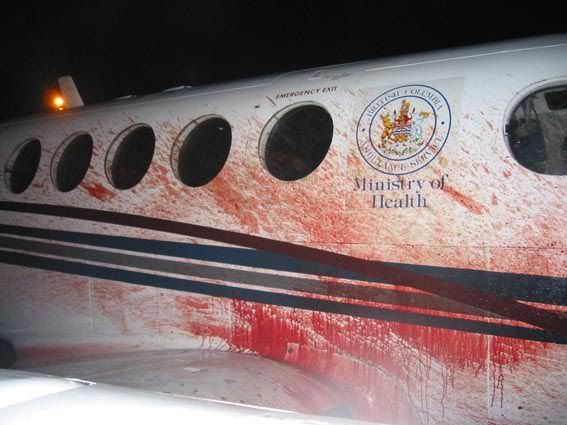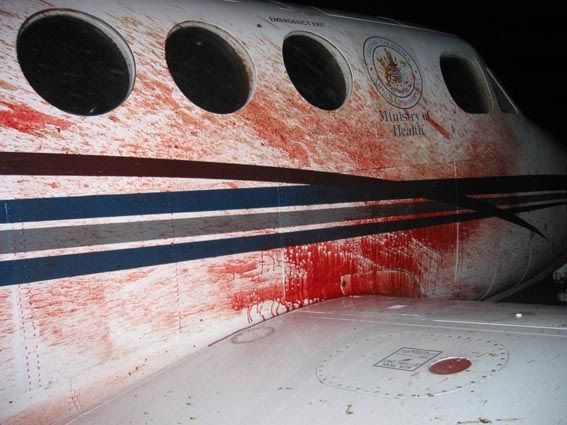Prop food...
Moderators: lilfssister, North Shore, sky's the limit, sepia, Sulako, I WAS Birddog
Prop food...
Just was reading about the GPU that got eaten by a prop and was wondering what other stuff people have seen props chew up. Lets hear some prop strike stories and pics if you got em.
I have yet to prop strike anything myself so all I can say is somehow over the ocean at 3500' a bumble bee made it past the prop and made a cool smear on my windshield. Why would a bee be cruising around at 3500 ten miles off shore, I have no idea.
I have yet to prop strike anything myself so all I can say is somehow over the ocean at 3500' a bumble bee made it past the prop and made a cool smear on my windshield. Why would a bee be cruising around at 3500 ten miles off shore, I have no idea.
I do recall just over a year ago, a certain company based out of YKZ was contracted to do the maintenance on another company's PC12 fleet. Anyways, engineer did a run-up with the tow bar still attached. Can you hear 'tink tink tink tink tink" all the way around? Yeah, you can still see the scuffs on the two bar today.
Haven't seen anything too exciting, but we do get cones chewed up all the time. At least every couple months some pilot doesn't think his walkaround should include moving a cone out from in front of the prop he is about to start, and he gets dinged the $20 for a new cone. That's usually about all that happens except for a red face though.
-
co-joe
- Rank 11

- Posts: 4733
- Joined: Mon Feb 16, 2004 2:33 am
- Location: YYC 230 degree radial at about 10 DME
A few years ago I was just about to do a PPC in YMM with TC and a guy started talking to me. I gues I looked pretty nervous so he starts saying that if TC pulls the know it all card about something to remind them about a particular incident.
Apparently one of their inspectors was taxiing a twin otter on the ramp there and had a brake failure. Forgetting that he had reverse thrust at his disposal he munched another aircraft parked on the ramp with one of his props before finally coming to a stop.
Now the funniest part was when he showed me the picture. He said they still keep it on the fridge in their luinch room and laugh at it periodically to this day.
Apparently one of their inspectors was taxiing a twin otter on the ramp there and had a brake failure. Forgetting that he had reverse thrust at his disposal he munched another aircraft parked on the ramp with one of his props before finally coming to a stop.
Now the funniest part was when he showed me the picture. He said they still keep it on the fridge in their luinch room and laugh at it periodically to this day.
-
co-joe
- Rank 11

- Posts: 4733
- Joined: Mon Feb 16, 2004 2:33 am
- Location: YYC 230 degree radial at about 10 DME
The 748 rings a bell. I think it was Calm air going into York Landing or Oxford Hole or something like that. They have an emergency braking system that uses an accumulator and can be applied a few times after the regular system has failed. Well apparently that failed too and they turned the terminal building into a pile of match sticks.
How an aircraft with no reverse thrust is still allowed a balance field exemption in the north is beyond me. They're what? 30 thousand pounds, and they can fly out of a 3000' strip without having to meed acelerate stop/ accel go? I guess northern lives are worth less than southern ones?
How an aircraft with no reverse thrust is still allowed a balance field exemption in the north is beyond me. They're what? 30 thousand pounds, and they can fly out of a 3000' strip without having to meed acelerate stop/ accel go? I guess northern lives are worth less than southern ones?
CJ your ignorance shows. the 48 is between 43500-46500# mlw is 43500. I personally have had that thing stopped in 1800' WITHOUT BRAKES." mind you we were light"At 39K The 748 is like the DC3, NOTHING CAN REPLACE IT. BTW reverse thrust is not allowed in asda calculations. I think if the props on the 748 were spinning you'd see a lot more damage. looks more like a careless pushback from the boeing
http://aviation-safety.net/database/rec ... 19980520-0rigpiggy wrote:I think if the props on the 748 were spinning you'd see a lot more damage. looks more like a careless pushback from the boeing
I'm thinkin he performed the overrun drill. The prop would remain in fine pitch to prevent additional and unwanted thrust as it slowly wound down.grimey wrote:Fatass wrote:I would have to say that prop was spinning when that happened. It's looking pretty curled up.
Yea, all 4 blades are bent. Kinda odd there's so little damage to the Airbus, though.
-
co-joe
- Rank 11

- Posts: 4733
- Joined: Mon Feb 16, 2004 2:33 am
- Location: YYC 230 degree radial at about 10 DME
I did know that Doc, I fly a 704 airplane. So the fact that you can stop in 1800 feet makes it okay to operate a passenger carrying aircraft into a 3000' gravel runway? So what happens when one engine packs it in at V1?Doc wrote:co-joe...did you know that, reverse thrust is not a factor in acc/stop distances? It's brakes only.....I guess you didn't know that?
My ignorance rigpig? Why because I don't know the gross of a hawker that makes me ignorant? Okay, I'll rephrase:
The fact that TC allows an exemption to the Hawker 748 which has a weight of 43 500 and 46 500 with a glw of 43 500 for balanced field calculations is retarded and only shows that life is worth less in the north.
Despite the fact that reverse thrust is not factored into calculations, the use of reverse thrust adds a safety margin that will improve book numbers. If you argue this then you're the ignorant one piggy.
Co-joe
The 748 meets balanced/unbalanced field performance as well as single engine go around performance. It's a 705 aircraft, no exemptions.
The t/o weight is limited by field and WAT performance calculation. These calculations are suppose to ensure a reject prior to V1 will allow the aircraft to stop in the cofines of the runway, or stopway if used. Or a failure at V1 can continue the takeoff roll and clear the end of the runway, or clearway if used by 35 feet, clear obstacles at toca by 35 feet and continue climb to 1500 feet above aerodrome elevation.
3000 feet of runway is quite normal for the 748, it'll will just usually be quite restricted to lower t/o weights.
The 748 meets balanced/unbalanced field performance as well as single engine go around performance. It's a 705 aircraft, no exemptions.
The t/o weight is limited by field and WAT performance calculation. These calculations are suppose to ensure a reject prior to V1 will allow the aircraft to stop in the cofines of the runway, or stopway if used. Or a failure at V1 can continue the takeoff roll and clear the end of the runway, or clearway if used by 35 feet, clear obstacles at toca by 35 feet and continue climb to 1500 feet above aerodrome elevation.
3000 feet of runway is quite normal for the 748, it'll will just usually be quite restricted to lower t/o weights.
Now I may be a bit on the ignorant side about something I guess. Not much multi engined experience. But how does reverse thread give you extra safety margine? I thought it was a bad idea to use this if you have an engine failure at say just before V1? Not preaching, just a bit confused.
Wahunga!
co-joe,
In regards to the exemption that you are refering to:
Is it a "grandfather" clause?
Does each company that runs a 748 have to apply for this exemption?
What else besides balanced field does the exemption cover?
Just wondering.
Thanks in advance. 206
P.S. I'll understand if you don't know.
In regards to the exemption that you are refering to:
Is it a "grandfather" clause?
Does each company that runs a 748 have to apply for this exemption?
What else besides balanced field does the exemption cover?
Just wondering.
Thanks in advance. 206
P.S. I'll understand if you don't know.
C+P from the above link, I stand corrected the props were obviously in spooldown.
Narrative:
Iberia returned to Johannesburg on 20th May 1998, after a break in service of at least 10 years. The inaugural flight was operated by A.340 EC-GJT and arrived at JNB around 07.30 in the morning. After the inaugural flight ceremonies were completed, the aircraft was towed away to be parked at a remote stand for the layover before the 21:00 departure. During the afternoon, an Intensive Air HS-748 (ZS-XGY) suffered a hydraulic system failure as it was taxying behind the parked Airbus. This failure affected both steering and braking systems and led to a collision between the two aircraft. The no. 1 propeller struck the rear fuselage as HS-748 passed beneath the Airbus' tail. The vertical stabilizer of the HS-748 then folded as the plane became wedged underneath the A.340.
Both aircraft suffered major damage. The inaugural Iberia flight back to Madrid was cancelled and the aircraft underwent temporary repairs at SAA before a
low-level ferry flight to Airbus at Finkenwerder approximately 2 weeks later.
It's been a number of years since flying the budgie, still one of my favourites. correct on 43k mlw. out of a 3000' strip, we were limited to 43,5 until we had wind, then add roughly 500# per 3 kts or thereabouts someone current will know better. wiith ground fine selected it's like selecting barn doors open, the brakes w/maxarets are really touchy ie: pax eat the headrest in front of them, so the captain only used them unless in an emergency.
Narrative:
Iberia returned to Johannesburg on 20th May 1998, after a break in service of at least 10 years. The inaugural flight was operated by A.340 EC-GJT and arrived at JNB around 07.30 in the morning. After the inaugural flight ceremonies were completed, the aircraft was towed away to be parked at a remote stand for the layover before the 21:00 departure. During the afternoon, an Intensive Air HS-748 (ZS-XGY) suffered a hydraulic system failure as it was taxying behind the parked Airbus. This failure affected both steering and braking systems and led to a collision between the two aircraft. The no. 1 propeller struck the rear fuselage as HS-748 passed beneath the Airbus' tail. The vertical stabilizer of the HS-748 then folded as the plane became wedged underneath the A.340.
Both aircraft suffered major damage. The inaugural Iberia flight back to Madrid was cancelled and the aircraft underwent temporary repairs at SAA before a
low-level ferry flight to Airbus at Finkenwerder approximately 2 weeks later.
It's been a number of years since flying the budgie, still one of my favourites. correct on 43k mlw. out of a 3000' strip, we were limited to 43,5 until we had wind, then add roughly 500# per 3 kts or thereabouts someone current will know better. wiith ground fine selected it's like selecting barn doors open, the brakes w/maxarets are really touchy ie: pax eat the headrest in front of them, so the captain only used them unless in an emergency.

















